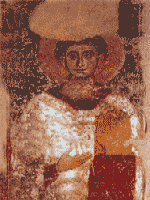Arianism – First Conflict Within the Church
A heretical and largely forgotten extinct sect of Christianity rocked the church of 4th century AD. The Arians, or followers of Arius of Alexander, created a separate dogma that taught that Jesus was a creation of God but was so significant he should be worshipped as God. God was to pure to be the ever exist before us on earth and never gave birth to a son. Jesus was the word of God according to Arians followers, but was divine enough because he spread the word of God and thus became a sort of inferior God himself.
How did the dispute come to be? Wasn’t it clearly defined in the new testament that Jesus was the son and not the creation of God? The dispute had arisen over a single letter of a word in the fourth gospel. The Greek word ‘homoousios’, meaning “of one substance”, was the typical word used in Greek translations of the Bibles and the one used by those opposed to Arius‘ ideology. ‘Homoiousios’ was the term used by the followers of Arius which is translated to mean ‘of like substance’. If Jesus was like God but wasn’t god, then it would only be logical that these two beings were indeed two separate beings. Arius proclaimed his ideas loudly. His call was not heard in most of Catholic Europe and so he wielded power only in what is now parts of the Middle East such as Egypt and Syria. Far from the walls of Jerusalem Arius’ version of Christianity was also taken up many of the German peoples who ruled vast areas across Europe (such as the Visigoths, Ostrogoths).
Who was this man who created such a schism in Christianity? Arius of Alexandria was a Libyan by descent and birth and was a pupil of the infamous Lucian of Antioch. He was born in approximately c.250-c.336. He climbed the ladder quickly through the ranks of the Catholic church. He raised the issue of Jesus’ unity with God and was excommunicated shortly thereafter from the Church as a heretic. Toward the end of his life however, he would go through communion once more even while retaining his beliefs publicly and the Roman Emperor Constantine would allow him back into the church. With Arius’ death, the debate in the council of Nicene (a council called created by the emperor for the discussion of the issue) did not calm down as many of the bishops of the east supported his Arius’ arguments for the separation of God and Jesus from one another.
Arianism as a practice did indeed die but died hard. There were essentially three forms of Arianism. One, known as radical or extremist Arianism, supported the idea that Jesus was ‘anomoios’ or unlike God. The next form of Arianism, which is the one Arius himself supported was the one which called for Jesus being set side by side with God but keeping Jesus inferior when compared to God. Both of these movements died within good time; the radical party was never very popular and the form of Arianism created by Arius would also die early with the Nicene creed of Christianity being excepted by most bishops by 357 A.D. . The last form of Arianism, also known as the Semi-Nicene creed, would keep the idea the Jesus was of like substance of God, but didn’t say much else or compare Jesus to other created beings.
What had happened to the final branch of Arianism? The last type of Arianism was able to survive for hundreds of years after Arius’ death. It spread to the German peoples as mentioned above and created churches in places as far off as Spain. However, because it was so vague in it’s understanding of the origin of Jesus, it was easily pushed aside for more orthodox views in the centuries following Arius’ demise.
Arianism has impacted Christianity significantly and was the first major schism in the church. While the church did eventually recover, other sects a millennia would pick up the ideas of Arius and implement them in their own church. Many churches such as the Unitarians and Jehovah’s Witnesses have seemingly adopted Arianism into their own ideology. The schisms of the past are those of the present and never before has a conflict like the one of Christ’s origins ever been so hotly debated. Jesus would continue to be in a trinity with God in accordance to Catholic traditional teachings.
Work Cited
“Arianism.” mb-soft. 1997. mb-soft. 28 Sep 2008
<http://mb-soft.com/believe/txo/arianism.htm>.
“Image:Arius.gif.” Wikipedia . Wikipedia The Free Encyclopedia. 28 Sep 2008 <http://en.wikipedia.org/wiki/Image:Arius.gif>.
Slick, Matthew. “Arianism.” CHRISTIAN APOLOGETICS & RESEARCH MINISTRY . 1995. CHRISTIAN APOLOGETICS & RESEARCH MINISTRY . 28 Sep 2008 <http://www.carm.org/heresy/arianism.htm>.
First post!
Welcome to my new blog 43beliefs. On this blog, I intend to discuss historical and current conflicts between different belief systems (whether they be political, religious, ethnic or other) and also talk about how these conflicts have played out. Whether it be issues within the holy church, Muslim Arabs slashing away at one another, or conflict between peoples, it’s all going to be discussed here. Comment and I will respond. If you have any questions or any tips/pointers, please do share. I’m new to blogging and any advice, good or bad, is appreciated. Till later,
~ 43reasons
